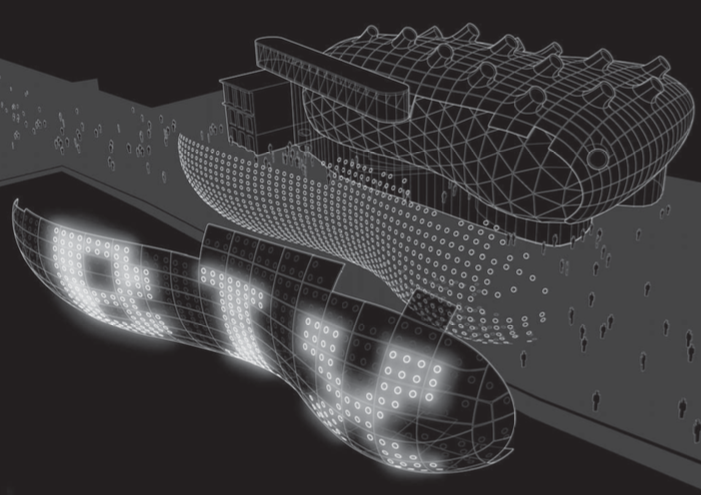So the terms I highlighted sort of grasped my attention, and I think it could be interesting for us to include a similar reflection in our project. I think we already made a move in that direction by deciding to integrate the loudspeakers in the existing staircase architecture, but I would like to shift the focus a bit towards the acoustic situation.
- How can we create a situation where the environment and our work are perceived as a single entity, rather than as two separate units (background / piece)?
- What would it mean for our installation to have (acoustic) "edges" that are not always perceptible?
- Is it possible, and do you find it meaningful, to think about our installation as an entity with no recognisable boundaries? What would that mean in concrete?
- Amorphous zone: how could this concept be tranlsated into the sound domain?
- By thinking in this terms - trying to establish the highest integration possible between the work and the space - would you expect to achieve some form of aesthetic result that is different from the sum of the two?
edges
Since I'm interested in the relationship between process and form, I was wondering whether some kind of generative process was involved in the project of the Kunsthaus. Given its characteristic "blobitecture" shape I was expecting so but, as it turns out, the physical model - which was originally submitted for the competition - was hand-made, and only later digitalised and structurally optimised through computer aided design. Later on, in the same book, the BIX project - the light and media installation on the Kunsthaus facade - is discussed. They put an emphasys on how the installation is highly integrated into the architecture in a way that it doesn't feel like an addition, a separate entity, but rather a sort of skin that feels part of the alien itself.
{function: question, keywords: [process, form, generative, blobitechture, alien]}
Sharing the same scale, the architecture and the media installation together generate new aesthetic results. It is not a separately mounted video wall but the Kunsthaus itself that radiates characters and images; the projection and the building achieve an extremely high level of integration as a single entity. The 930 lights of the BIXinstallation seem to be “tattooed” onto the skin of the building like individual spots of pigment. The light matrix does not constitute a rectangular field with straight sides, but rather an amorphous zone tailored to the complex shape of the building and gradually fading away towards the edges. Hidden behind the acrylic glass façade, only the active light rings are visible, while the rest of them remain invisible behind the skin so that the installation’s edges are not always perceptible. Thus one has the impression that the blue bubble itself renders the light patterns from within. In the absence of a recognizable boundary, it looks as though the light patterns could dance freely on the outside skin of the building [1].
[1] Kolarevic, B., Malkawi A. (2005). Performative Architecture: Beyond Insturmentality. London, Routledge. pp. 156-157
[I think we touched upon some related themes during Ron's iteration, when we talked about the plausibility of a work (Max Neuhaus)]
{kind: note}
---
meta: true
author: POZ
artwork: ThroughSegments
project: AlgorithmicSegments
function: proposal
keywords: [questions, proposal, brainstorming]
---
affection
I find fascinating to work with synthesis processes that can generate sound forms out of implemented relationships. In my practice this is often achieved through bottom-up processes, in which I consider the modelling of the relationships among the elements that compose the system the crucial point of the work. Generally I use very few elements, and spend much more time and effort in designing and calibrating the joints among them. This also implies thinking how an element could affect the others and, viceversa, how that element could int turn be affected. There is a point where the design of these affection scheme takes precedence and occupies an aesthetic context in itself.
Basically, I'm trying to understand if it makes sense to introduce some of these ideas in our situation. How could our 4 instances relate to one another, besides the acoustic relationship that will anyway happen simply by sharing the same physical space? Which kind of data do we need to exchange, and what type of "receptors" shall we integrate in our systems in order to realise a form of mutual affection that goes beyond simple communication (OSC message->"hey, I'm playing now") - something that resembles more a structural coupling and that somehow occupies an aesthetic context in itself? What's the difference between affection, influence and communication?
{function: question, keywords: [process, form, generative, relationships, data, protocol, communication, OSC]}
presence / absence
To occupy: to fill, exist in, or use a place or period of time
How can we think of the relation between the space we work in and the sound that will occupy it? When do we perceive sound as "occupant"? Can we distinguish at all between a presence or absence of sound? If yes, what movements do articulate the transitions between the two? What's the relationship between the space of a sound (its spectrum) and the sound in space? And what the one between the temporal dimension of a sound and its perceived spatiality (presence/absence/movement)?
{function: question, keywords: [presence, absence, space, sound, movement, transitions, spectrum]}
